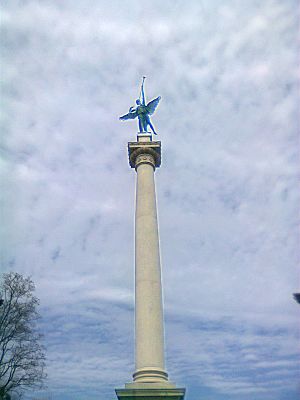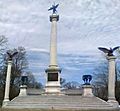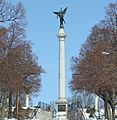Elijah P. Lovejoy Monument facts for kids
Quick facts for kids Lovejoy Monument |
|
|---|---|

The 110 foot tall spire of the Lovejoy monument
|
|
| Location | Alton, Illinois |
| Area | 106.01 acres (0.4290 km2) |
| Established | 1897 |
| Built | 1897 |
| Architect | R. P. Bringhurst |
| Visitors | 467,550 (in 2005) |
| Governing body | Greater Alton/Twin Rivers Convention and Visitors Bureau |
| Lua error in Module:Location_map at line 420: attempt to index field 'wikibase' (a nil value). | |
The Elijah P. Lovejoy Monument in Alton, Illinois, honors a brave man named Elijah Parish Lovejoy. He was a strong supporter of free speech and worked to end slavery in the 1830s. Lovejoy died fighting for these important ideas when his newspaper, the Alton Observer, was attacked by people who supported slavery. This monument stands as a reminder of his courage and sacrifice.
Contents
The Story of Elijah Lovejoy
A Voice for Freedom
Elijah Parish Lovejoy was an abolitionist in the 1830s. An abolitionist is someone who believes slavery should be completely ended. Lovejoy used his newspaper, the St. Louis Observer, to share his views. He lived in Missouri, which was a state where slavery was allowed.
Facing Danger for His Beliefs
Because of his strong opinions against slavery, Lovejoy's newspaper presses were attacked and destroyed several times. This forced him to move across the Mississippi River to Alton, Illinois, in 1837. He renamed his newspaper the Alton Observer. Even though Illinois was a free state (meaning slavery was not allowed), the danger followed him.
A Tragic End
In November 1837, his newspaper presses were attacked for the fourth time. Lovejoy and his supporters were trying to protect their equipment in a warehouse. During the attack, shots were fired, and Lovejoy was killed.
A Martyr for Liberty
Lovejoy's death gained national attention. Many people, especially those who wanted to end slavery, saw him as a hero who died for the causes of free speech and ending slavery. Even Abraham Lincoln spoke about Lovejoy's importance, saying his death was a very significant event for freedom in America.
Building a Memorial
Elijah Lovejoy was first buried in an unmarked grave. Years later, his remains were moved to a cemetery that is now overlooked by his monument. In the 1890s, work began to build a proper memorial for him. The monument was designed by R. P. Bringhurst, a sculptor from St. Louis, and built by the Culver Stone Company.
Exploring the Monument's Design
A Towering Tribute
The Lovejoy Monument is very tall and impressive. It has a main shaft that is 93 feet high. On top of this shaft is a 17-foot-tall statue of victory with wings. This means the very top of the monument stands over 300 feet above the Mississippi River below.
Unique Features
The monument also includes two smaller spires, each topped with an eagle. There are also two bronze lion statues. A special stone bench, called a whispering wall, wraps around the central spire. If you whisper on one side of the wall, someone on the opposite side can hear you, even if they are out of sight!
Visible from Afar
Because the monument is built on top of the river bluffs, you can easily see it from far away. It's even visible when you cross the bridge from Missouri into Illinois, which is quite a distance.
Words of Wisdom
The four sides of the central monument's base have quotes from Elijah Lovejoy himself. These quotes highlight different parts of his life and beliefs:
- Champion of Free Speech: This quote shows his strong belief in the right to speak, write, and publish freely, as long as it follows the law.
- Salve, Victores! (Hail, Victors!): This part honors the brave people who defended the press alongside Lovejoy. It mentions their fight against slavery in America.
- Minister of the Gospel: This quote shows his deep faith. He said he would appeal to God if the laws failed to protect him, and that he would die at his post rather than abandon his beliefs.
- Elijah P. Lovejoy, Editor Alton Observer: This section gives his birth and death dates. It also includes his powerful promise: "I have sworn eternal opposition to slavery, and by the blessing of God, I will never go back."
Gallery











